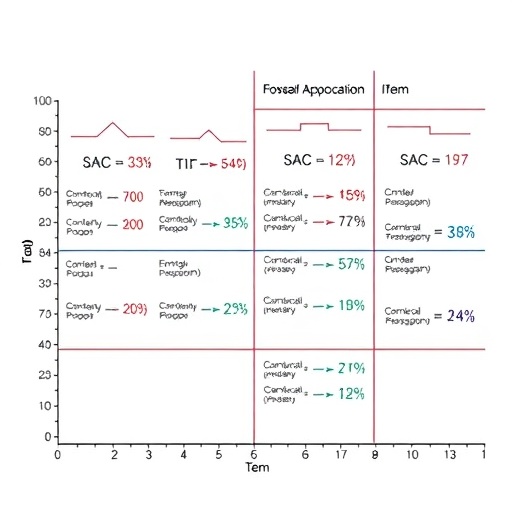In an increasingly data-driven world, the education sector is beginning to harness the power of advanced statistical methods to enhance assessment tools. One emerging area of focus is the exploration of differential item functioning (DIF) and its effect on the accuracy of item model fit. The research presented by Uzun and Öğretmen digs deeply into this significant issue, illustrating how the concurrent equating method might be deployed to address these complications and thus ensure that educational assessments reflect true student abilities without bias.
DIF occurs when individuals from different groups (e.g., based on gender, ethnicity, or socioeconomic background) interpret test items differently, resulting in unfair advantages or disadvantages. This phenomenon can jeopardize the validity of educational assessments and skew the results, leading to misguided conclusions about student performance and ability. In their study, Uzun and Öğretmen assess the implications of DIF on the overall fit of item response models, a critical component in the evaluation of educational assessments.
To this end, the researchers employ a concurrent equating method, a relatively novel approach that enables the comparison of item performance across different test forms while accounting for potential DIF. This technique not only facilitates the identification of items that function unevenly across selected groups but also offers insights into necessary adjustments for ensuring fairness in assessments. The methodology discussed in this paper serves as a vital tool for educators and psychometricians alike, aiming to derive accurate interpretations of assessment outcomes in diverse educational contexts.
As the field of psychometrics evolves, the implications of these findings extend beyond the realms of academic assessments. Educational policymakers may use these insights to develop more equitable testing practices that support all students, promoting inclusivity and fairness. It advocates for a paradigm shift in how assessments are designed and evaluated, ultimately leading to improved educational strategies that cater to the diverse needs of learners.
One of the pivotal aspects of the research is the rigorous statistical analysis employed to determine the extent of DIF in various test items. The methods employed are grounded in item response theory (IRT), which serves as the backbone for many modern assessment tools. By applying IRT principles, the authors provide a robust framework for identifying bias and ensuring item fairness, thus enhancing the overall predictive validity of educational assessments.
The concurrent equating method introduced by Uzun and Öğretmen stands out for its potential integration into large-scale testing programs. In a practical sense, this method could be invaluable for state and national assessments, where the stakes are high and the implications of results can significantly influence educational policy and student opportunities. The authors provide compelling evidence that timely interventions based on this method can help mitigate the adverse effects of DIF in standardized testing environments.
In examining the broader implications of their findings, the authors point to the cultivation of a culture of assessment literacy among educators. Understanding DIF and the associated statistical techniques ensures that teachers and administrators are better equipped to interpret test results meaningfully. This knowledge empowers them to make informed decisions about curriculum design and instructional approaches that cater to a diverse range of learners, enhancing overall educational outcomes.
Moreover, the study reinforces the necessity of ongoing research in this domain. As educational contexts continue to evolve—especially in light of global trends in mobility and diversity—the mechanisms that underpin assessments must adapt correspondingly. The insights from Uzun and Öğretmen’s work shed light on the importance of maintaining a responsive and agile approach to educational evaluation, ensuring that assessments remain relevant and effective.
In addition to informing policy and practice, the insights gained from this research could also contribute to the expanding body of literature on educational equity. Highlighting how certain test items may inherently privilege certain demographics over others raises significant questions about systemic practices that have long been entrenched in educational systems. One of the primary goals should be to address these disparities in a substantive manner, fostering a more inclusive environment that acknowledges and values diversity.
Finally, Uzun and Öğretmen’s research acts as a powerful reminder of the interplay between assessment design and educational equity. The need for careful consideration of fairness in assessments cannot be overstated. Their work not only underscores the mechanical aspects of item functioning but also calls into question the broader ethical considerations inherent in educational assessments. As communities and educational institutions strive for equality in learning outcomes, such rigorous investigations stand as beacons of hope.
In conclusion, the study into differential item functioning provides critical insights into the complexities of assessment practices in education. By addressing the impact of DIF and implementing methods such as concurrent equating, we can pave the way for fairer and more equitable learning environments. The unyielding pursuit of excellence in education is, after all, inherently tied to our ability to design assessments that truly reflect the capabilities and potential of every student.
This research is not just a technical discussion; it is an essential chapter in the ongoing narrative of educational reform. It is a clarion call to all stakeholders in the education sector to commit to continuous improvement and vigilance in their assessment practices. The learning landscape is shaped by the instruments we use, and the voices of all learners must resonate equally within it.
Subject of Research: The impact of differential item functioning on educational assessments using concurrent equating methods.
Article Title: Impact of differential item functioning on item model fit using concurrent equating method.
Article References:
Uzun, Z., Öğretmen, T. Impact of differential item functioning on item model fit using concurrent equating method.
Large-scale Assess Educ 13, 15 (2025). https://doi.org/10.1186/s40536-025-00244-z
Image Credits: AI Generated
DOI: 10.1186/s40536-025-00244-z
Keywords: differential item functioning, concurrent equating, educational assessment, item response theory, assessment fairness, statistical methods in education, educational equity, psychometrics.




